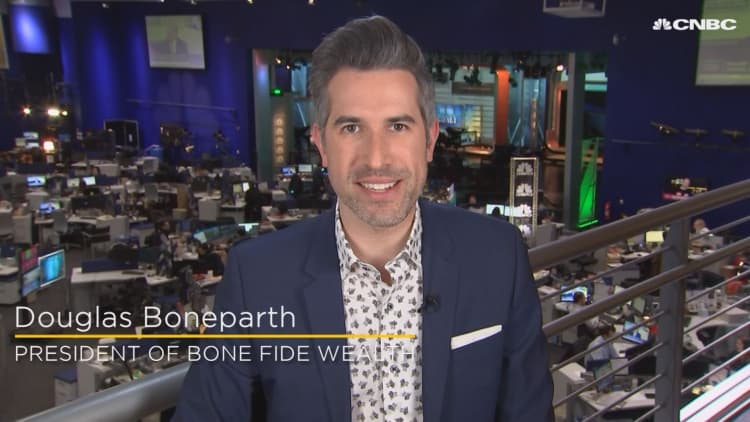Doug Boneparth may not have the Twitter reach of Taylor Swift or Barack Obama, but the 24,000 people who follow the financial planner took to heart a recent message. It proved that 280 characters can be worth at least $1,000.
The tweet did not exactly go viral, but for the president of New York City-based financial advisory firm Bone Fide Wealth — who tweets early and often (as much about money as his love of coffee) — the $1,000 tweet definitely ranked as a top performer.
"If likes were money, I would have $1,000," he said. "That tweet struck a chord. Something people were not expecting."
The question from investors that got Boneparth riled up enough to tweet about is the idea that there is a specific place to invest $1,000. But the advisor claims that if someone has to ask the question in the first place, then it is a "strong indication" that the individual has not built the necessary fundamentals to be investing at all.
"Anyone with a clear understanding of goals and mastery of cash flows would know exactly what to do with $1,000," he said. "The amount is telling and further indicates where you are in the scheme of things. Why bother to speculate with $1,000? A hot stock pick shows me you are not thinking long term. Nothing reveals you are not ready to invest like asking for stock picks."
Why you should never fear missing out
It is hard to give up the gains that you see others are getting — especially the closer it comes to seeming like the opportunity may be nearing an end. After a decade of impressive returns across many public companies, from IPOs to tech-sector growth stories and blue-chip stocks, the uninvested might feel even more pressure to put any money they have to work in the market. But Boneparth said people need to understand that there is work to be done before you earn the right to invest. Fear of missing out does not grant that right. Buying an individual stock should never be confused with a long-term strategic investment plan.
Nothing helps people sleep better at night than having a cash reserve.Doug Boneparthpresident of Bone Fide Wealth
"When you have finally earned the right to invest, it will more than likely coincide with disciplined, diversified long-term strategic investing. When you are investing for the long term, you want consistent average returns that drive the goal."
Boneparth said earning the right to invest means understanding that the maximum reward an investor should expect is related to the amount of risk the investor should take.
If an investor wants to speculate with an opportunity investment — no more than 5% to 10% of an overall investment — a side portfolio comprised of fresh IPOs or even blue chips, that is distinct from the disciplined investing that would be in the best interest of people new to the markets.
"The way investments have been sensationalized creates the illusion that people are missing out on something, to the detriment of having a strong financial foundation," Boneparth said.

What you should do with the first $1,000
An individual is in no position to put money at risk before they have figured out the fundamentals. That means for many the first place to put the first $1,000 is a high-yield money account "where you can make a real rate of return on money," he said.
There are many high-interest savings accounts available, and intense competition in the financial services industry to offer the highest rate is a good thing for savers.
Online financial advisory platform Wealthfront recently bumped up its FDIC-insured cash account interest rate from 2.29% to 2.51%, which according to Bankrate.com is now the highest in the industry. Since launching in February, the cash account already has taken in $1 billion in customer deposits. The old guard on Wall Street are also making a big play for these dollars, with Goldman Sachs' mass market online financial effort, called Marcus, offering a cash account with a rate of 2.25%.
Recent research indicates that many American adults remain unable to cover relatively small emergency expenses. Near 40% of Americans surveyed by the Federal Reserve said that they could not cover an unexpected $400, with 27% saying they would need to borrow money or sell something, and another 12% saying they had no way to cover the $400.
More from Invest in You
The five steps to your first $10,000
How to cut back on spending and afford a home
Millennials had been good at staying out of debt. Not anymore
Getting organized means paying down credit card debt and building a cash reserve. But it also means not letting reductive headlines about spending get the better of you or get you down. Boneparth just launched a financial calculator online that allows people to see how spending on coffee can change long-term investing outcomes. But it is not really about coffee. It is all about taking control.
"This whole buzz around the 'latte factor' isn't about how much money we spend on coffee. The calculator could have been created for just about any expense, large or small, and it would have told you the exact same thing: the monetary impact of a financial decision. This is all truly about control. Control over your spending and, to a much greater extent, control over your financial life," Boneparth wrote in a blog post.
Some individuals with their first $1,000 ready to invest may have done their homework and researched stocks, but Boneparth says that makes them no better positioned to follow through on a stock purchase.
"Even if you have researched specific stocks, you have not built a strong financial foundation," he said. Any form of thinking about putting $1,000 into a stock is about short-term gains and not long-term success.
"What good is investing when you don't know what you are investing for? You need to first prioritize goals and master cash flow or else there is no point in investing."
If you don't get them right, Boneparth says you are much more likely to start investing in the worst possible way: by making a mistake.

Boneparth does not ignore the most powerful counterargument: The power of compound interest means that the earlier an individual invests, the more that wealth can grow over time.
"This flies in the face of that, but these concepts, these foundational components, are far more important than compounding interest. Nothing helps people sleep better at night than having a cash reserve. That will help you sleep a lot better than wondering whether a stock you bought will be the next successful IPO."
Boneparth's advice can run counter to ideas taken as sacred in the world of investing: Start early and invest often, such as in a 401(k) plan offered by an employer.
"There is something to be said for a matching contribution from an employer, but even there I hesitate if you truly have no safety cushion. Cash will be the most appropriate thing while you get organized," he said.
Boneparth is prepared to get the question again and again. "It will always be asked," and that is not such a bad thing.
"I welcome the question because it is a teachable moment. It is up to me to make sure that person doesn't feel like I am making them feel put down. Show them a better way. Make them feel and know they are not missing out, and they will feel better knowing that they are on the right track."
Check out With this easy side hustle, I made $1,000 by taking pictures via Grow with Acorns+CNBC.
Disclosure: NBCUniversal and Comcast Ventures are investors in Acorns.






